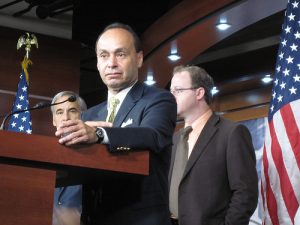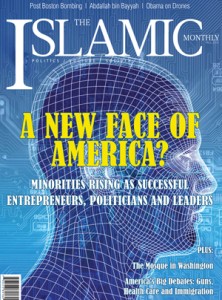Last month, the first session of the 113th Congress came to an end, and many wondered whether Congress will deliver on one of the most highly publicized issues of 2013: immigration reform. The Senate passed its version of a comprehensive overhaul of the immigration system on June 27 with a significant bipartisan vote of 68-32 (including 14 Republicans voting in favor). Despite early promises from the House leadership that they could “no longer kick this can [immigration] down the road,” the House has delayed action. Thus far, Republican Speaker John A. Boehner has made it clear that he has no intention of taking up the Senate bill, instead allowing the ultra-conservative leaders of the House Judiciary Committee to shape individual bills that will create a “step-by-step” approach to reform. The bills that have emerged from the committee fall far short of a comprehensive solution, and in some cases, look backward to divisive enforcement-only strategies that were repudiated in the last election.
Among the most talked about differences between the Senate and the House is the idea that the roughly 11 million undocumented immigrants living in the United States should be able to obtain a legal status that leads eventually to citizenship, or a “path to citizenship.” While polls suggest that the public overwhelmingly supports this idea, and it was the centerpiece of the Senate proposal, House leadership has been slow to embrace public opinion. Over the summer, particularly during the August recess, immigration activists pushed Republicans to come out in favor of a path to citizenship. To date, at leastt 26 House Republicans have done so, almost all of them between the end of July and Labor Day. Added to the roughly 200 Democrats said to favor a path, this represents a clear majority of House members. John McCain and Lindsey Graham, Republicans who helped lead the fight in the Senate, along with prominent supporters of reform have challenged Boehner to give the country a vote on citizenship, with McCain emphasizing that without immigration reform, the Republican Party may be doomed.
Then why the reluctance? Why hasn’t immigration reform sailed through Congress? The answer could be attributed to political gridlock in Washington, but far more is involved and at stake when talking about immigration reform. Immigration is frequently a stand-in for deeper social issues that the country isn’t always willing to confront head on. As such, the politics of immigration have been nasty and brutish at times, and nowhere was it more evident than after the attacks of Sept. 11, when years of careful work toward reform were swept aside in a hysteria that treated all immigrants as the enemy. Unfortunately, this type of xenophobia hasn’t disappeared; it reared its head again during the Republican presidential primaries, where candidates like Herman Cain called for an electrified fence to keep immigrants from crossing the border and Representative Michele Bachmann railed against “anchor babies,” suggesting the elimination of Fourteenth Amendment rights to citizenship at birth. While some of this vitriol has subsided, the goal of crafting a workable immigration system that will help the United States maintain its global leadership in the 21st century remains hobbled by nativism and fear of change. Whether the House is able to overcome those fears and draft something comparable to the Senate’s major overhaul will ultimately tell us more about the members of Congress than it will about immigration reform.
To understand what could happen in the House either in the waning days of the session or in 2014, it is useful to recap not only the Senate debate, but also the basics of U.S. immigration law and policy and how the country emerged ready for reform in 2013.
What is the Immigration and Nationality Act?
Although Americans routinely acknowledge that the United States is a nation of immigrants, the system of laws that govern who can immigrate, who can visit, who can stay and under what conditions is largely unknown to most people. The Immigration and Nationality Act (INA) of 1952 is a complex and often confusing collection of laws that does everything from setting forth qualifications for naturalization to regulating foreign students to managing temporary workers and authorizing humanitarian protections such as asylum and refugee admissions. The INA also contains quotas or limits on the number of legal immigrants who may come to the country each year, numbers that were last adjusted in 1990. Over the years, the INA has also authorized “relief” from deportation — various laws that allow an individual to make the case that he or she should be permitted to enter or remain in the United States, despite being in violation of the immigration law, based on family unity, contributions to the community or other humanitarian concerns. Similarly, the INA has been amended numerous times to enlarge or restrict access to the United States  based on characteristics such as country of origin, occupation, humanitarian concerns, criminal convictions, occupations or affiliations. Critics of these amendments routinely argued that we are either too generous or too restrictive in whom we allow to enter and remain in the United States, setting the stage for political arguments that have little to do with immigration itself and far more to do with issues of race, economics, culture and identity.
based on characteristics such as country of origin, occupation, humanitarian concerns, criminal convictions, occupations or affiliations. Critics of these amendments routinely argued that we are either too generous or too restrictive in whom we allow to enter and remain in the United States, setting the stage for political arguments that have little to do with immigration itself and far more to do with issues of race, economics, culture and identity.
What kinds of events prompt changes in immigration law?
Immigration reform is often fueled by other elements of social change, when the American public realizes that the immigration law lags other social reforms. For instance, against the backdrop of the civil rights movement, the 1965 amendments to the INA eliminated biases in the law that favored European immigration over others. In 1980, after the refugee crises brought on by the Vietnam War, Congress enacted refugee and asylum provisions that brought the United States into compliance with international standards of refugee protection. In 1986, driven by increased illegal immigration and few means to control it, Congress created a trade-off — legalization of approximately 3.5 million undocumented immigrants in exchange for requiring all workers to establish their eligibility for employment in the United States. By 1996, when illegal immigration was still not in check, many in Congress blamed the more generous provisions of the INA for this problem. In response, Congress enacted a harsh new immigration removal scheme that eliminated or restricted many forms of relief; required mandatory detention and removal for many immigration violations; and authorized extensive or permanent bars on admission after a deportation. In subsequent years, the severity of these measures and the hardships experienced by many undocumented immigrants who had fled civil wars and violence in Central America, Haiti and former Soviet Union countries led Congress to pass some small legalization programs, but nothing on the scale of the 1986 law. On Sept. 10, 2001, President George W. Bush and President Vicente Fox of Mexico announced plans for a new temporary worker program and other immigration reforms, brought about by a booming economy, efforts to build a stronger partnership with Mexico and a rise in undocumented immigration.
On Sept. 11, 2001, that initiative and many others fell by the wayside, to be replaced with enhanced national security and terrorism laws, many of which attempted to regulate possible threats to the country through restrictions on immigration. Muslims, Arab Americans and others from Middle Eastern countries were subject to additional scrutiny and harassment as they sought immigration benefits; many who were entitled to become naturalized citizens found themselves in an interminable limbo while their background checks were delayed and prolonged. Ironically, this backlash helped to reinforce one of the most important principles of the current reform effort — immigration and civil rights are inextricably linked. In fact, the way we treat immigrants — whether they arrive on our shores legally, enter unlawfully or overstay a visa — reflects the worst and best of the United States as a nation founded on rights.
What is behind the current effort on immigration reform?
It is fair to say that the 2013 immigration reform initiatives had their genesis in the 1996 law itself, which enhanced immigration penalties but eliminated many forms of relief. That imbalance in the immigration scheme, coupled with a decade of strong economic growth, created a jobs magnet in the United States and decreased the likelihood that undocumented immigrants would return to their home countries. At the same time, the numbers of non-violent, non-criminal immigrants arrested for immigration violations increased due to mandatory detention policies and expanded immigration enforcement, including mass workforce raids and greater federal/state/local law enforcement cooperation through programs like Secure Communities. With little relief available under the INA, deportations of undocumented immigrants were almost inevitable, despite the fact that many of them had lived in the country for a decade or more and had family members who were U.S. citizens or lawful permanent residents. The sheer volume of deportations and their well-documented impact on the disruption of family life and communities, the growing economic, demographic and political strength of immigrants and their children, and increased evidence that anti-immigrant measures, such as Arizona’s SB 1070, resulted in discrimination, racial profiling and hate crimes against people of color have all contributed to the growing awareness that an immigration crisis exists in the United States. Political polling after the 2012 elections further clarified that many voters, particularly those of Latino and Asian descent, believed that a politician’s negative views on immigration reflected a bias against them, regardless of their place of birth.

Rep. Luis Gutierrez (D-Ill.) speaks on immigration reform.
Photo courtesy of Talk Radio News Service/Flickr.
For Senators Charles Schumer (D-New York), John McCain (R-Arizona), Robert Menendez (D-New Jersey), Lindsey Graham (R-South Carolina), Richard Durbin (D-Illinois), Jeffrey Flake (R-Arizona), Michael Bennet (D-Colorado), and Marco Rubio (R-Florida), who quickly became known as the “Gang of 8,” these changing political winds gave them the room to restart discussions on reform that had been on again/off again (with a changing cast of characters) since 2009. Although Schumer and Graham had managed to publish a joint set of principles in 2010 calling for comprehensive reform, they could not bring other Republican senators into the fold at the time. The 2012 elections gave new impetus to the effort, however, and after months of painful negotiations, the Gang of 8 introduced S 744 on April 16 this year. This was the first bipartisan, comprehensive immigration bill introduced in the Senate since 2007, when Edward Kennedy of Massachusetts and Jon Kyl of Arizona led a coalition that brought a bill to the Senate floor twice in that year without reaching cloture. In contrast with 2007, 82 senators voted to bring S. 744 to the floor and ultimately 68 voted for its final passage.
Why is the path to citizenship so important?
Central to the Senate bill is its proposal for transitioning the undocumented to a legal status (for a complete analysis of S. 744, see the Immigration Policy Center’s guide). Like virtually every legalization proposal since 2004, the Senate’s bill allows unauthorized immigrants who have lived in the country for a set period of time, have no significant criminal record and pass background checks, to register for a conditional legal status. These “Registered Provisional Immigrants” (RPIs) have to earn their way to a green card through employment, paying taxes, learning English and continuing to obey the law. Thirteen years after initial registration, those who make it will become citizens. Legislation that provides more streamlined paths for young people brought to the country as children (the DREAM Act, Development, Relief and Education for Alien Minors) and agricultural workers (AgJobs) is also incorporated into the program, but with shorter waiting periods between registration and a green card. The long lead-time for RPIs, however, is designed to defeat one of the most common arguments against giving undocumented immigrants legal status — they shouldn’t be able to jump ahead of those patiently waiting in line. Unfortunately, the current supply of visas available for those who seek to immigrate based on a family or employment connection is so backlogged that there is a wait of as many as 20 years in some categories. Consequently, the bill also authorizes the secretary of Homeland Security to issue sufficient visas to eliminate those backlogs (and also significantly restructures family and employment visas).
 The 13-year delay also builds in sufficient time to ensure that certain enforcement “triggers” are met, including various border security plans, proving operational control of the border through apprehension metrics and phasing in a mandatory electronic employment verification system (E-verify) to replace the paper I-9 system currently in use by most employers. These triggers have proved particularly controversial, with proponents of reform arguing that the fate of the undocumented should not be tied to whether the government meets its legal requirements, but with critics arguing that we shouldn’t even be talking about legalization until we have proved the border is completely secure. This led to one of the most heated votes during the Senate floor debate in June, when Republican Senators Michael Hoeven of North Dakota and Bob Corker of Tennessee conditioned their support for the bill on an additional set of border requirements and $6 billion in funding for the border. Senator Schumer, in particular, saw these amendments as necessary concessions for bringing along such an overwhelming number of Republicans that the House would feel compelled to take up the Senate bill — and quickly.
The 13-year delay also builds in sufficient time to ensure that certain enforcement “triggers” are met, including various border security plans, proving operational control of the border through apprehension metrics and phasing in a mandatory electronic employment verification system (E-verify) to replace the paper I-9 system currently in use by most employers. These triggers have proved particularly controversial, with proponents of reform arguing that the fate of the undocumented should not be tied to whether the government meets its legal requirements, but with critics arguing that we shouldn’t even be talking about legalization until we have proved the border is completely secure. This led to one of the most heated votes during the Senate floor debate in June, when Republican Senators Michael Hoeven of North Dakota and Bob Corker of Tennessee conditioned their support for the bill on an additional set of border requirements and $6 billion in funding for the border. Senator Schumer, in particular, saw these amendments as necessary concessions for bringing along such an overwhelming number of Republicans that the House would feel compelled to take up the Senate bill — and quickly.
What will the House do?
The massive Senate bill, more than 1,000 pages long and covering everything from the path to citizenship to a dramatic reform of the temporary worker system, was eyed warily by many in the House, who countered that it was too long, too complicated and gave too much away. Privately, many staffers suggested that the House would never simply take up the Senate’s bill, but would need to craft something that worked for its more diverse and unruly membership. Two general approaches were evident by mid-summer: a House bipartisan bill that had also been in the works for years or a series of bills that taken together could replicate a comprehensive approach but allow members to pick and choose which parts they would support. After returning from the August recess, however, the house bi-partisan group dissolved without introducing its bill, bowing it seems to a preference from House leadership for the step by step approach.
Prior to the stand-off over the government shutdown and the debt ceiling, Budget Committee Chairman and former vice presidential candidate Paul Ryan, had predicted that the House would take up a series of votes on immigration in October. While that timeline may have been delayed by gridlock, the general consensus remains that Republicans need to show movement on immigration reform this year—and after the general drubbing in public opinion polls caused by the shutdown, swift action on immigration reform could help to reverse Republican fortunes. To keep momentum going, House Democrats Joe Garcia of Florida, Jared Polis of Colorado, Steven Horsford of Nevada, Judy Chu and Xavier Becerra of California, and Suzan DelBene of Washington introduced H.R. 15, a modified version of the Senate bill on October 2. In an effort to bring sympathetic House Republicans on board, they cut the border surge provisions of the Senate bill, replacing it with the bipartisan language from a border bill that passed the House Homeland Security Committee unanimously. By Nov. 11, more than , 180 of the 201 Democrats in the House had signed on as co-sponsors. Even more significantly, three Republicans signed on in the weeks leading up to election day.
The 2013 elections have added to the pressure, on Judiciary Chairman Bob Goodlatte (R-Virginia) and other Republican leaders to put forth a package of bills for a vote. In fact, election eve polls found that inaction on immigration has further weakened Republican standings among Latinos and Asians. This should strengthen the hand of supporters of H.R. 15, who are challenging Republicans who have signaled they support a path to citizenship, to sign on to the bill or produce something else. Theoretically, that “something else” could be a series of carefully coordinated bills that addressed each aspect of the immigration system, from border to benefits to worksite enforcement to legalization. Reports of various proposals—from a Republican version of the DREAM Act to a temporary legal status bill to a bill addressing temporary and seasonal workforce issues—have all been rumored, but have yet to see the light of day. Even an incomplete set of bills — say on high-skilled immigration, undocumented youth and border enforcement — could provide sufficient substance for the House and Senate to confer, leading to a bill that took (ideally) the best of the Senate and House versions for one final comprehensive package that could be voted on before the end of the year.
Assuming that the House continues on the “step-by-step” approach, it must still present a coherent vision that is based on the functions of the immigration system. Thus, reforming the system requires looking at the various functions of our immigration laws: to protect the borders, to regulate the admission of people who want to live and work here temporarily or permanently, to provide humanitarian protections to those in need, and to ensure that those who violate the laws receive an appropriate penalty. There is a humanitarian and political imperative to resolve the legal status of the roughly 11 million unauthorized immigrants in the United States, and this has been a central component of virtually every immigration overhaul proposal offered since 2004. Other critical components to a systemic approach include: creating a fair but realistic means for regulating future immigration needs; securing our borders and safety through efficient application of new enforcement strategies and technologies; ensuring that our system welcomes new immigrants; and ensuring that all immigration laws respect the principles of due process on which this country is based.
Each of these issues plays out differently, depending on who writes the bill, what the political issues of the day are, and what the market will bear. For instance, S. 744 ultimately contained far more border enforcement provisions as a result of amendments thought to be politically necessary for passage. Similarly, numerous concessions were made in regulating future family-based visas (including the eventual elimination of a category allowing the siblings of U.S. citizens to immigrate) based on strongly held political opinions of some of the sponsors. At the same time, S. 744 contains one of the most generous provisions ever introduced for allowing family members to return to the U.S. after deportation as well as significant reforms in immigration detention, immigration courts, and asylum and refugee law. Regardless of its flaws (and there are many), the bill represented genuine compromise, negotiation and debate in which an ideal was matched against political realities.
The great risk of the Speaker Boehnner’s step-by-step strategy is that it will have all of the political fighting with none of the compromise. Bills that are conceived independently, without a coherent vision, are not likely to mesh easily. Notably, the quality of existing House bills is wildly uneven. While the chairman of the Homeland Security Committee, Michael McCaul (R-Texas), produced a border security bill that passed unanimously out of committee, and Representative Darrell Issa (R-California) has written a high skilled visa bill that has garnered much interest, there is no bill yet that addresses the path to citizenship. House Majority Leader Eric Cantor (R-Virginia) is still expected to introduce a bill designed to provide some type of legal status for young people brought to the U.S. as children (generally called “Dreamers” in reference to the DREAM Act). If anything, many of the ultra- conservatives in the House have dug in their heels against a path to citizenship, insisting that undocumented immigrants should have no “special path” to a green card, but should be able to acquire citizenship only through existing channels (which are woefully inadequate to address current demand for green cards). Nonetheless, there appears to be room for conservatives and liberals to come together on legalization, despite the rhetoric, especially when members hear that the details of the Senate legalization program, including a 13-year wait to citizenship, are neither easy nor special.
Perhaps even more disturbing, Goodlatte and Trey Gowdy (R-South Carolina), the chairman of the Immigration Subcommittee, pushed through the Judiciary Committee a blatantly anti-reform bill, the SAFE Act, which would entrench the worst of the enforcement-only measures that have been the source of so many of our immigration problems for years. Among other things, the SAFE Act would make unlawful presence in the United States a criminal act punishable with jail time, greatly expand detention of immigrants, authorize states and local governments to create their own immigration enforcement laws and impose harsher penalties and restrictions for immigration violations.
Thus, at the very time when the speaker is attempting to reassure the public that the House will take up immigration reform, his generals are championing a bill that harkens back to attrition through enforcement and an expansion of punitive immigration measures. The mixed message makes little sense as a policy matter, and could prove fatal politically.
That is the crux of the matter. From a policy perspective, it has long been clear that a working immigration system — one that respects individual rights, fosters economic growth, protects workers and gives employers a measure of certainty about the availability of labor, that brings the undocumented out of the shadows, and that uses resources more wisely for targeted enforcement — is critical to the country’s future. From a political perspective, this appears  increasingly true as well. For years, opposition to immigration reform was a reliable means to attract certain voters, but that pool of voters is drying up. Instead, a new voting bloc — one that is younger, racially diverse and tired of gridlock — is increasingly expecting Congress to fix the problems caused by a malfunctioning immigration system.
increasingly true as well. For years, opposition to immigration reform was a reliable means to attract certain voters, but that pool of voters is drying up. Instead, a new voting bloc — one that is younger, racially diverse and tired of gridlock — is increasingly expecting Congress to fix the problems caused by a malfunctioning immigration system.
The opportunity to do this is still alive, if the speaker follows the will of the people. In Congress, timing is everything, so whether the moment comes in the next few weeks or sometime in 2014, when the time is right, the pieces will fall into place.









